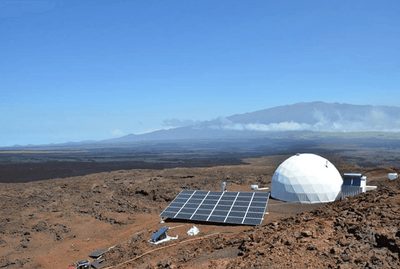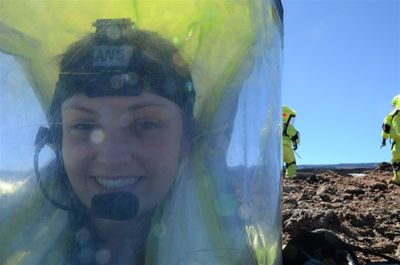HI-SEAS Mission V, the Earth-based Mars simulation habitat implemented by the University of Hawaii and funded by NASA, uses the ESTECO flagship software, modeFRONTIER, to optimize the resources used by the six-member crew during their analog isolation at Mauna Loa volcano in Hawaii. modeFRONTIER will help the astronaut-like researchers develop system models for sustainable living on Mars, in particular in terms of waste reduction and sustainable lifestyle.
Hawaii Space Exploration Analog and Simulation (HI-SEAS), a NASA-funded research project aimed to help determine the individual and team requirements for long-term space exploration missions, relies on modeFRONTIER to develop resource-effective system models for life on Mars.
HI-SEAS V is an 8-month Mars analog isolation mission that begun on January 19th, 2017. Another 8-month mission is scheduled to start in January 2018. During the Mission V, six researchers are studying human behavior on ‘Mars’ by living in a geodesic dome in the isolated environment of Mauna Loa volcano on the Hawaii Big Island, including 20-minutes delayed communication and partial self-sufficiency. Their purpose is to directly address the IRP Team Risk: “Risk of Performance Decrements Due to Inadequate Cooperation, Coordination, Communication, and Psychosocial Adaptation within a Team”.
“On a space mission, the astronaut crew is very limited on what they can bring along. Every item you send on a rocket needs to be weight and size efficient, including food, water, research materials, and personal effects. When you are traveling far away, like a manned mission to Mars, you need more supplies and you have to burn more fuel to get everything there - this makes resource optimization even more challenging”, said Ms.Ansley Barnard, the Engineering Officer for Mission V in charge of monitoring life support systems.
Before joining HI-SEAS, Barnard worked in engineering optimization at Ford Motor Company where she got familiar with the advantages of modeFRONTIER for reducing weight, cost and engineering time.

“Parametric modeling and optimization software tools like modeFRONTIER provide us with faster and more robust ways to optimize. It is possible to find trends that your human eyes might have missed, yielding better solutions in less time. modeFRONTIER is an easy to learn tool with a lot of built-in capability and modular flexibility. It is possible to tailor the software to specific needs”, she added.
Ms.Barnard underlined that tools like modeFRONTIER can help the Mission in modeling systems, but that changes then need to be carried out through human action. Her goal is to make a tangible difference in how her crew mates live day-to-day in their mission and provide future HI-SEAS crews with updated engineering information on the habitat life support systems.
Barnard has a BS in Aeronautics and Astronautics from the University of Washington and hopes to serve as a US Astronaut in the future.
For more information about the HI-SEAS: hi-seas.org
About modeFRONTIER: esteco.com/modefrontier

